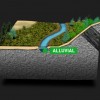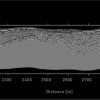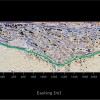Although the scale of placer mining ranges from artisanal gold panners to massive dredging operations, the importance of a priori knowledge of the complex subsurface geology of the paleofluvial environment is critical to resource exploration, project economics, as well as mine engineering. Of primary importance is information related to bedrock topography and gain-size distribution within the fluvial facies. Mine geologists require information on the bedrock topography, as the highest concentrations of precious metals or gemstones are generally found in coarse-grained gravels in bedrock troughs such as paleothalwegs. The financial viability of a placer mine often depends on the stripping ratio, which is the volume of overburden material required to be removed to access the high-grade gravels. Data related to the thickness of overlying sands as compared to the thickness of coarse basal gravels may determine that a project is not viable. In addition, open pit placer operations generally need to be de-watered during mining, making data related to bedrock topography and grain-size distribution important for mining engineers.
Traditionally, boreholes or trenches are placed at set intervals across a known or suspected paleochannel in order to map bedrock topography and fluvial lithology. However, these techniques are costly and often produce results which are unrepresentative of the true complexity of a deposit. In order to mitigate these drawbacks of traditional exploration, geophysical techniques are increasingly employed to provide data continuity between boreholes or test pits. Techniques such as refraction seismic, electrical imaging or electromagnetic surveying suffer from either inadequate resolution or high costs. UltraGPR offers an ideal solution to the problem of paleochannel mapping using sparse boreholes or test pits.



